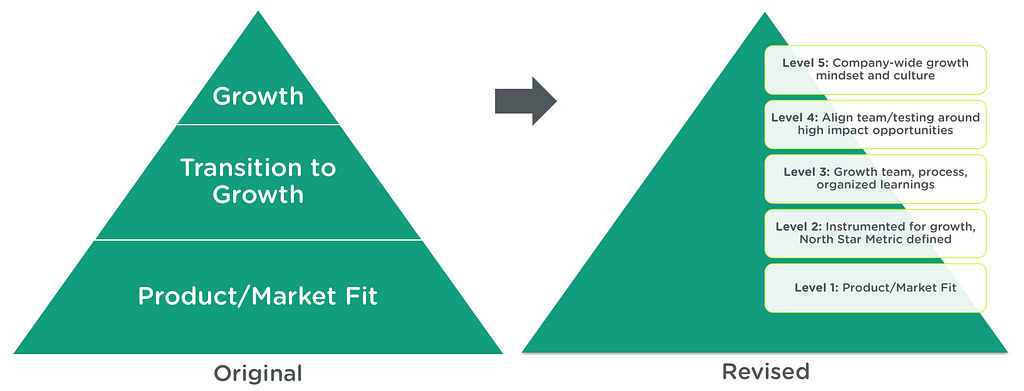Growth Hacks: The Growth Pyramid Revisited
Ready to Hack Growth?
The Growth Pyramid Revisited

A lot of people are asking how Dropbox became the fastest growing SaaS business ever, reaching a $1B revenue run rate in record time.
I saw signs of this explosive growth when I joined Dropbox in an Interim VP Marketing role one week after the public launch in 2008. Of course, Dropbox is a fantastic product, which really helped, but that doesn’t tell the whole story.
Kady Srinivasan, Dropbox’s current head of worldwide digital marketing, captured the key to their growth when I interviewed her last month at the GrowthHackers Conference. She explained that what’s unique about Dropbox is that the “entire company takes ownership of growth.” Below is a short snippet of that interview.
https://medium.com/media/5f722faccd995fd2210bc423ede71ae2/href
Compare this to slower growing companies where team members are often isolated in their functional silos and believe they must rely on the marketing department to pour an ever-increasing amount of resources into advertising to accelerate growth.
This growth culture at Dropbox might seem like a fortunate accident, but it wasn’t. One of the key goals that Drew Houston and I discussed when I joined the team was to create a culture of growth and experimentation across the full company. I’ll get to how we did that in a bit, but since that time I’ve realized that a culture of growth has also been key to the success of other breakout growth companies like Facebook and Airbnb.
Not long after I left Dropbox, I published a blog post outlining what I called “The Startup Pyramid.” It was based on the patterns I had seen taking five companies to market, two of which had already listed on NASDAQ. Below is the original pyramid and a new version that goes into more details about how to actually accelerate sustainable growth. As you can see, it ends with company-wide growth habits and culture.
The Growth Pyramid

The Milestones to Growth
There are several milestones that must be cleared before you can create a company-wide culture of growth.
1. Product Market Fit
The first is a product that people actually consider a “must have.” In the startup world, this is generally referred to as “product/market fit.”
2. Instrument for Growth & Define North Star Metric
Once you’ve validated product/market fit, it then becomes important to define an overall success metric. This success metric should be a “North Star Metric” for the entire team to gauge the success of the business. The right North Star Metric tracks cumulative value delivered across a growing customer base. This is a much more sustainable growth indicator than something like registrations, downloads or even revenue (many subscription businesses have inactive users that are still on a paid subscription but will likely churn).
It is important to instrument for growth so that you can truly understand what is happening. For example, at Dropbox, I wanted to be careful not to break what looked like to be a potentially powerful growth engine. I worked with the team to instrument tracking and reporting that would tell us exactly how new customers got started with Dropbox, which features they used first and ultimately how they used it on an ongoing basis. Just as importantly, I worked to understand why people did those things. During my first couple of months we sent out surveys almost daily.
Another important part of instrumenting for growth is testing tools such as Google Optimize, that allow you to implement a/b tests across your website and product. Finally, you’ll need a system to bring all of this information together so that your team can learn how to improve growth.
3. Growth Team, Process & Organized Learnings
Now you’re finally ready to start accelerating growth, which is level three of the pyramid. In this stage you should focus on building a growth team that can effectively execute a growth process.
The purpose of this growth process is to uncover better ways to accelerate growth in the business. Your goal here is just to build a rhythm and habit of testing. Every test you run will lead to additional learning — even if it doesn’t directly drive immediate improvement in growth. It’s important during this stage to catalogue this learning so that the team keeps getting smarter about how to accelerate growth.
4. Align Team & Testing Around High Impact Opportunities
Once you’ve built a testing habit within the growth team (ideally 2–3 tests per week), it’s time to start trying to maximize impact.
To drive full impact, you’ll need to be able to test across the entire customer journey (acquisition channels, new customer onboarding, referral hooks in product, etc.). This is where things start getting hard. The highest impact part of the customer journey is usually testing across the first customer experience.
At Dropbox, I needed to work via the CEO to drive initial testing here. It would have been surprising if the engineers would have agreed to run growth experiments at the expense of the long-term product roadmap if a marketer had asked them.
In a bigger company there are even more organizational barriers to testing across the full customer journey. One benchmark to consider is that the fastest growing consumer apps generally invest 50% of the product development resources in the first customer experience. It makes sense, because there is no second customer experience if you don’t nail the first one.
Getting permission to run this high impact testing often requires setting up an offsite meeting with the growth team, functional leaders and the CEO. My team can provide resources if you need help facilitating this meeting.
Once you’ve been given permission to test, it’s important to set up specific improvement objectives and track progress against them. This will help your team generate relevant ideas and keep everyone informed about progress.
5. Company-wide Growth Culture & Mindset
As you run higher impact testing, you should start to see some big wins. These big wins will be critical for driving broader team participation. At Dropbox, the engineering team quickly got on board the testing bandwagon when the saw the impact of the tests that they implemented.
Keeping a full team in sync around growth is not an easy task. Building the habit in the first place is even harder. But the effort is well worth it. No individual growth hacker or even a growth team can outperform a company where everyone is mobilized to accelerate growth. Get started on your path to breakout growth here.
The Growth Pyramid Revisited was originally published in Growth Hackers on Medium, where people are continuing the conversation by highlighting and responding to this story.
Join The Rockstar Entrepreneur Community Now: Start Rockin Now